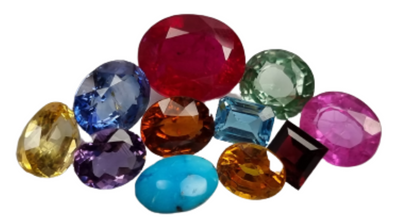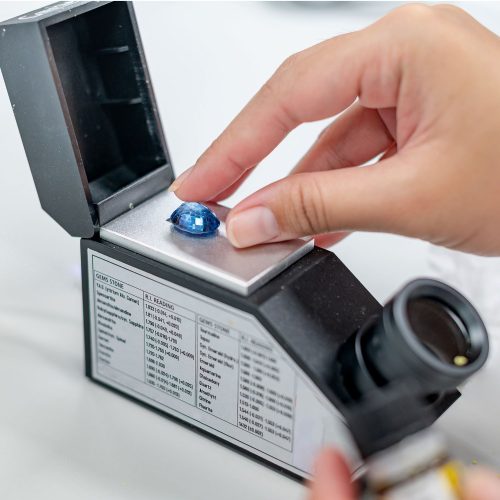Refractive Index (RI) is the slowing that is characteristic of since it travels through a given treasure species or substance. The higher the RI, the greater luster and brilliance can be done. The undeniable fact that each gem features its own RI causes it to be necessary to facet each species at slightly various angles and makes it a characteristic that is useful gem identification.
Light moves at its maximum velocity that can be done the lack of matter. For instance, in room light travels more or less 186,000 miles per second. But the presence of matter slows light straight down; or more specifically, the forces which bind atoms light that is slow. The Index of Refraction for any substance is the ratio associated with velocity of light in a vacuum to its velocity in a given substance. The bigger the index, the slower the velocity. Thus, it can go through that crystal if we state that a particular crystal has an index of refraction of 2.000 we suggest that light would pass through vacuum pressure at twice the velocity.
Why do different substances have various indices being refractive?
As previously pointed out, the velocity of light through any material is retarded by forces binding its atoms and molecules. Therefore, the level to which a beam that is particular of is slowed depends both upon the types of atoms current (the chemical composition) plus the nature associated with arrangement of those atoms.
For example, light travels in water at 3/4 of its velocity in a vacuum, so we assign a value of 4/3, or 1.333 as the index of refraction of water. But if we freeze that water into ice, a arrangement that is different of molecules results and the ice has a refractive index of 1.313. Or, if we boil water, yet another arrangement of the same particles is produced, which retards the light almost no, and the steam has a index that is refractive of.
In the complete situation of ice, water and vapor, we now have examples of three different states of matter; solid, liquid and gasoline. But, even when a state that is solitary of is recognized as, it must be remembered that exactly the same materials can frequently be arranged in different structures, which are reflected in the differing indices of refraction.
For example, common pure Quartz crystals have an index that is average of. But then cooled down to room temperature, the resulting fused silica-quartz has an index of 1.456 if the crystal is melted and. Or exactly the same silicon dioxide might also occur as tridymite, cristobalite, coesite or other differing crystal structures, each of which has a unique refractive index, although all have the chemical composition that is identical.
Does light always travel through a given crystal at the speed that is same?
No. Most minerals crystallize in an lattice that is orderly which has various sorts of inter-molecular bonds in different planes, similar to the grain in wood. The strength of those bonds may be very different in different planes.
The type of Calcite known as Iceland Spar presents an example that is outstanding of impact on refractive index in different optical directions, since a given crystal could have an index of 1.486 in one way and 1.658 in another. Fortunately (except for Rutile) many minerals used as gems do not widely vary so in different directions.
How many other factors affect the Refractive Index of a mineral?
Temperature associated with specimen influences its index, however if measurements are manufactured at a range that is normal of conditions, this effect is indeed small it can be neglected.
Impurities in a result is had by the specimen proportionate with their concentration in the specimen. For example, Opal consists mainly of a kind of silica known as cristobalite with an index of 1.487. But Opal frequently contains about 5 to 10% of water in its framework. Since water has an index of 1.33, Opals show an index somewhere within those two values, usually 1.43 to 1.46.
| Isotropic Minerals | |
| Mineral | Refractive Index |
| Fluorite | 1.43 |
| Analcime | 1.48 |
| Sodalite | 1.48 |
| Sylvite | 1.49 |
| Halite | 1.54 |
| Garnet | 1.71 – 1.87 |
| Periclase | 1.736 |
| Spinel | 1.74 |
| Chlorargerite | 2.07 |
| Diamond | 2.419 |
| Sphalerite | 2.42 |
| Cuprite | 2.85 |
| Uniaxial (-) Minerals | |
| Mineral | Refractive Index |
| Nitratite | 1.33 – 1.58 |
| Chabazite | 1.48 |
| Cristobalite | 1.48 |
| Calcite | 1.48 – 1.65 |
| Dolomite | 1.5 – 1.67 |
| Magnesite | 1.5 – 1.7 |
| Nepheline | 1.54 |
| Scapolite | 1.54 – 1.59 |
| Ankerite | 1.54 – 1.75 |
| Autunite | 1.55 – 1.57 |
| Beryl | 1.56 |
| Rhodochrosite | 1.59 – 1.81 |
| Tourmaline | 1.62 – 1.67 |
| Smithsonite | 1.62 – 1.85 |
| Apatite | 1.63 |
| Siderite | 1.63 – 1.87 |
| Vesuvianite | 1.7 |
| Corundum | 1.76 |
| Pyromorphite | 2.04 – 2.05 |
| Hausmannite | 2.1 – 2.4 |
| Wulfenite | 2.28 – 2.4 |
| Uniaxial (-) Minerals (continued) | |
| Mineral | Refractive Index |
| Vanadinite | 2.3 – 2.4 |
| Anatase | 2.48 – 2.56 |
| Proustite | 2.71 – 2.98 |
| Pyrargyrite | 2.88 – 3.08 |
| Hematite | 3 – 3.2 |
| Uniaxial (+) Minerals | |
| Mineral | Refractive Index |
| Leucite | 1.51 |
| Apophyllite | 1.53 |
| Quartz | 1.53 – 1.54 |
| Brucite | 1.57 – 1.58 |
| Alunite | 1.57 – 1.59 |
| Stishovite | 1.8 – 1.82 |
| Scheelite | 1.92 – 1.93 |
| Zircon | 1.93 – 1.99 |
| Zincite | 2.01 – 2.02 |
| Rutile | 2.61 – 2.9 |
| Cinnabar | 2.9 – 3.25 |
| Biaxial (-) Minerals | |
| Mineral | Refractive Index |
| Niter | 1.33 – 1.5 |
| Borax | 1.44 – 1.47 |
| Kernite | 1.45 – 1.48 |
| Stilbite | 1.5 |
| Sepiolite | 1.51 – 1.53 |
| Chalcanthite | 1.51 – 1.54 |
| Microcline | 1.52 |
| Orthoclase | 1.52 |
| Sanidine | 1.52 |
| Strontianite | 1.52 – 1.66 |
| Witherite | 1.52 – 1.67 |
| Aragonite | 1.53 – 1.68 |
| Talc | 1.54 – 1.58 |
| Variscite | 1.55 – 1.59 |
| Pyrophyllite | 1.55 – 1.6 |
| Kaolinite | 1.56 |
| Muscovite | 1.56 – 1.6 |
| Chlorite | 1.56 – 1.61 |
| Antigorite | 1.57 |
| Anorthite | 1.57 – 1.59 |
| Biotite | 1.57 – 1.61 |
| Amblygonite | 1.59 – 1.62 |
| Anthophyllite | 1.6 – 1.63 |
| Tremolite-actinolite | 1.61 – 1.63 |
| Lazulite | 1.61 – 1.64 |
| Wollastonite | 1.62 – 1.63 |
| Erythrite | 1.62 – 1.69 |
| Andalusite | 1.63 – 1.64 |
| Margarite | 1.63 – 1.65 |
| Monticellite | 1.64 – 1.66 |
| Glaucophane | 1.65 – 1.67 |
| Hornblende | 1.65 – 1.67 |
| Malachite | 1.65 – 1.9 |
| Clinozoisite | 1.67 – 1.73 |
| Triphylite | 1.68 – 1.69 |
| Kaersutite | 1.68 – 1.73 |
| Kyanite | 1.71 – 1.72 |
| Epidote | 1.71 – 1.8 |
| Carnotite | 1.75 – 1.95 |
| Cerussite | 1.8 – 2.07 |
| Atacamite | 1.83 – 1.88 |
| Lepidocrocite | 1.94 – 2.51 |
| Goethite | 2.26 – 2.52 |
| Perovskite | 2.3 |
| Realgar | 2.5 – 2.8 |
| Biaxial (+) Minerals | |
| Mineral | Refractive Index |
| Cryolite | 1.33 |
| Epsomite | 1.43 – 1.46 |
| Carnallite | 1.46 – 1.49 |
| Natrolite | 1.48 |
| Tridymite | 1.48 |
| Ulexite | 1.49 – 1.52 |
| Heulandite | 1.5 |
| Albite | 1.52 |
| Gypsum | 1.52 |
| Wavellite | 1.52 – 1.55 |
| Cordierite | 1.54 – 1.56 |
| Norbergite | 1.56 – 1.58 |
| Gibbsite | 1.57 – 1.59 |
| Anhydrite | 1.57 – 1.61 |
| Vivianite | 1.57 – 1.63 |
| Colemanite | 1.58 – 1.61 |
| Coesite | 1.59 |
| Pectolite | 1.59 – 1.63 |
| Clinohumite | 1.59 – 1.64 |
| Chondrodite | 1.6 – 1.63 |
| Topaz | 1.61 – 1.62 |
| Turquoise | 1.61 – 1.65 |
| Celestite | 1.62 – 1.63 |
| Prehnite | 1.62 – 1.65 |
| Barite | 1.63 – 1.64 |
| Olivine | 1.63- 1.88 |
| Boracite | 1.64 – 1.67 |
| Cummingtonite | 1.64 – 1.67 |
| Jadeite | 1.65 – 1.67 |
| Spodumene | 1.65 – 1.67 |
| Sillimanite | 1.65 – 1.68 |
| Hypersthene | 1.66 |
| Lawsonite | 1.66 – 1.68 |
| Diopside | 1.66 – 1.75 |
| Sinhalite | 1.67 – 1.71 |
| Diaspore | 1.68 – 1.75 |
| Pigeonite | 1.69 – 1.72 |
| Chloritoid | 1.71 – 1.72 |
| Rhodonite | 1.71 – 1.73 |
| Antlerite | 1.72 – 1.78 |
| Azurite | 1.73 – 1.83 |
| Chrysoberyl | 1.74 – 1.75 |
| Staurolite | 1.74 – 1.75 |
| Monazite | 1.78 – 1.85 |
| Titanite (sphene) | 1.86 – 2.1 |
| Anglesite | 1.87 – 1.89 |
| Sulfur | 1.95 – 2.24 |
| Wolframite | 2.1 – 2.5 |
| Manganite | 2.2 – 2.5 |
| Columbite | 2.3 – 2.4 |
| Crocoite | 2.3 – 2.6 |
| Orpiment | 2.4 – 3 |
| Brookite | 2.58 – 2.72 |





